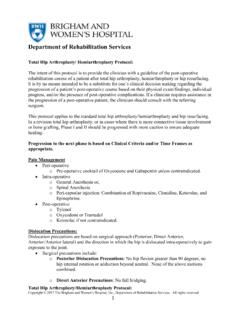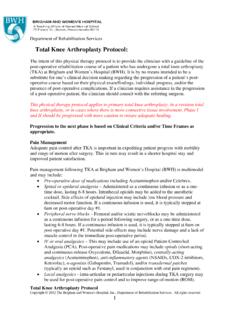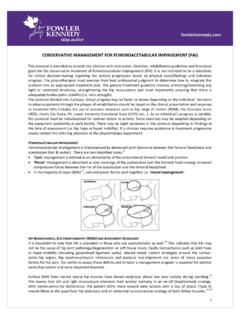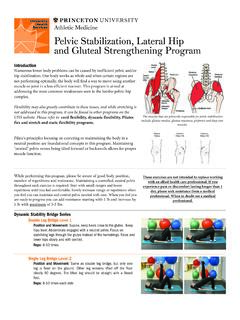Transcription of Lumbar Laminectomy/Discectomy Protocol
1 Jefferson C. Brand, Jr., James E. Andrews, Jr., Paul A. Dale, Siegfried P. Feierabend, Dennis P. Weigel, Timothy E. Lindley, , Russell S. Sticha, Emily Monroe, Thomas E. Dudley, Aaron J. Balgaard, Eric W. Nelson, Jonathan J. Harvey, Suite 101, 111 17th Ave, Alexandria, MN 56308 (320) 762-1144 Fax (320) 762-1935 Last Reviewed: 11/22/2019 Lumbar Laminectomy/Discectomy Protocol Timothy E. Lindley, , The below postoperative Protocol is intended to serve as a guideline. As with all therapeutic considerations, professional knowledge and judgment ( prior level of function, goals, overall health of the patient, and specific treatment orders per physician) should be utilized.
2 Gentle manual therapy techniques of scar mobilization and grade 1 and 2 spinal mobilization may be incorporated during phases II and III. Treatment guidelines, described in detail below, will consist of 3 phases: Phase I: Back Protection (0 to 6-8 weeks) Phase II: Education and Flexibility / Stabilization exercise (6-8 to 12 weeks) Phase III: Advanced exercise and Functional Activities (12 to 18 weeks) Phase I Back Protection (Week 0-6): May be initiated during a pre-surgical consult when appropriate. Inpatient physical therapy will focus on ambulation, bed mobility, functional transfers, basic spine protection principles, and reinforce brace application. Phase I will proceed further following hospital discharge.
3 Goals: 1. Decrease pain and inflammation 2. Monitor for signs of infection 3. Increase activity tolerance 4. Educate on bed mobility and low-level body mechanics 5. Promote postural awareness 6. Independence in home exercise program to include 15 minutes of home exercise program and 15-30 minutes of aerobic exercise ( walking, stair climbing or stationary bike) Precautions: 1. No standing ROM testing or manual muscle testing of hip flexion/trunk flexion 2. No lifting beyond 15 pounds for the first 6 weeks then progressing as directed by your provider or therapist. 3. No twisting or bending of the Lumbar spine for 6-8 weeks. 4. Limit sitting for 30-45 minute intervals for the first 4 weeks. 5. No driving for the first 2 weeks, and only after consulting with your doctor.
4 No driving when taking narcotic pain medication. When driving, drive in short intervals and progress slowly. Avoid manual transmissions in the early phases. Intervention: 1. Instruction in bed mobility, transfers, and body mechanics education with ADLs 2. Instruction in basic home exercise program: a. Bed exercises i. Ankle pumps ii. Gluteal sets iii. Quadriceps sets iv. Hamstring sets Jefferson C. Brand, Jr., James E. Andrews, Jr., Paul A. Dale, Siegfried P. Feierabend, Dennis P. Weigel, Timothy E. Lindley, , Russell S. Sticha, Emily Monroe, Thomas E. Dudley, Aaron J. Balgaard, Eric W. Nelson, Jonathan J. Harvey, Suite 101, 111 17th Ave, Alexandria, MN 56308 (320) 762-1144 Fax (320) 762-1935 Last Reviewed: 11/22/2019 v.
5 Heel slides vi. Long and short arc LE extension vii. Transverse abdominis isometric contractions viii. Breathing relaxation exercises b. Bedside exercises i. Heel raises ii. Mini squats c. Walking Criteria for Progression: 1. Pain within tolerance 2. HEP tolerance of 15 minutes 3. Cardiovascular exercise tolerance of 15-30 minutes 4. Independent self-cares/hygiene Phase II Education and Flexibility/Stabilization exercise (Week 6-9): Goals: 1. Patient education 2. lower extremity and trunk range of motion deficits to within normal limits 3. Gait analysis 4. Return to ADLs 5. Progression of spine stabilization Precautions: 1. No twisting or bending of the Lumbar spine 2. Avoid loading of the Lumbar spine Intervention: 1.
6 Education: a. Body mechanics b. Pain and stress management (if condition is of a chronic nature) 2. Flexibility: a. Hamstring with neural flossing avoiding symptom provocation b. Piriformis c. Groin d. Hip Flexor e. Gastrocnemius/Soleus f. Quadriceps g. Pectoralis 3. Gait: Normalization of any gait deviations as appropriate 4. Stabilization: a. Week 6-7: supine and Sidelying i. Train neutral spine in supine and side-lying positions with diaphragmatic breathing. ( supine single arms, single legs, single arms and legs, supine leg lowering, and bridging to tolerance). Jefferson C. Brand, Jr., James E. Andrews, Jr., Paul A. Dale, Siegfried P. Feierabend, Dennis P. Weigel, Timothy E. Lindley, , Russell S.
7 Sticha, Emily Monroe, Thomas E. Dudley, Aaron J. Balgaard, Eric W. Nelson, Jonathan J. Harvey, Suite 101, 111 17th Ave, Alexandria, MN 56308 (320) 762-1144 Fax (320) 762-1935 Last Reviewed: 11/22/2019 ii. Advance, if neutral spine is able to be maintained, to partial sit ups, partial diagonal sit ups, bridging with tiny steps, bridging with leg extension and dead bug. b. Weeks 7-8: Prone Stabilization activities i. Train neutral spine positioning with pillow(s) under pelvis to avoid excessive extension ii. Prone stabilization exercises in neutral spine position along with diaphragmatic breathing (ie. Prone with single arms, single legs and single arms and legs). iii. Advance, if neutral spine is able to be maintained, to prone with double arms, double legs and double arms and legs.
8 C. Weeks 8-9: Quadruped & Standing Stabilization activities i. Train neutral spine positioning in quadruped position ii. Quadruped stabilization exercises in neutral spine position along with diaphragmatic breathing ( Quadruped single arms, single legs and single arms and legs). iii. Train neutral spine positioning in standing iv. Partial lunges v. Walking with co-contractions of multifidus and transverse abdominis vi. Initiate balance activities as appropriate 5. Manual therapy: Mobilizations over restricted joints above/below level of surgery to increase contribution to overall movement. Criteria for Progression: 1. Mastery of Phase II exercise components 2. Patient demonstrating proper body mechanics 3.
9 Patient tolerating 30 minutes of cardiovascular exercise each day Phase III Advanced exercise and Functional Activities (Week 9-12): Goals: 1. Progress strengthening and core stability exercises 2. Progress stabilization exercises in standing and with functional activities 3. Advance balance activities Intervention: 1. Education: Continued body mechanics training 2. Flexibility: Continue range of motion exercises for LEs and t-spine as needed. Nerve mobilization without symptom provocation. 3. Stabilization/ strengthening : a. Advance balance and stabilization activities i. Use of therapy ball as appropriate (sitting, supine , quadruped) b. Advance lower extremity strengthening exercises c. Incorporate higher-level functional core strengthening activities as it pertains to home and work environment 4.
10 Manual therapy: Mobilizations over restricted joints above/below to increase contribution to overall movement. 5. Cardiovascular training: Treadmill, UBE, Stationary Bike 6. Consider FCE Jefferson C. Brand, Jr., James E. Andrews, Jr., Paul A. Dale, Siegfried P. Feierabend, Dennis P. Weigel, Timothy E. Lindley, , Russell S. Sticha, Emily Monroe, Thomas E. Dudley, Aaron J. Balgaard, Eric W. Nelson, Jonathan J. Harvey, Suite 101, 111 17th Ave, Alexandria, MN 56308 (320) 762-1144 Fax (320) 762-1935 Last Reviewed: 11/22/2019 Discharge: 1. Strength within normal limits 2. Independent HEP 3. Trunk and hip range of motion within normal limits








